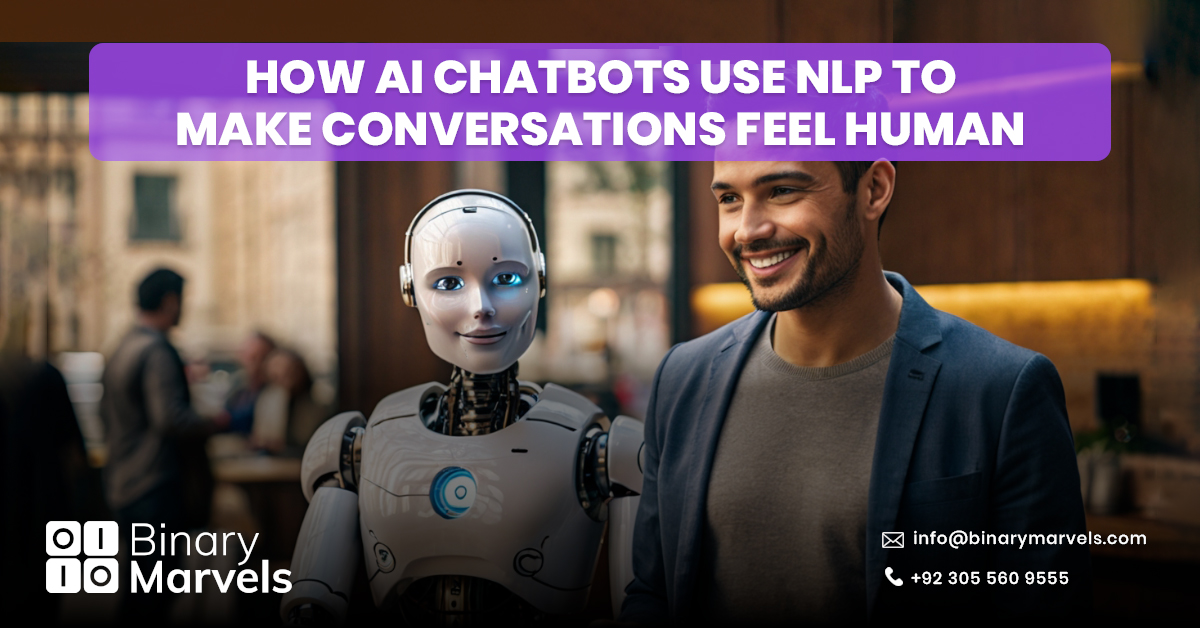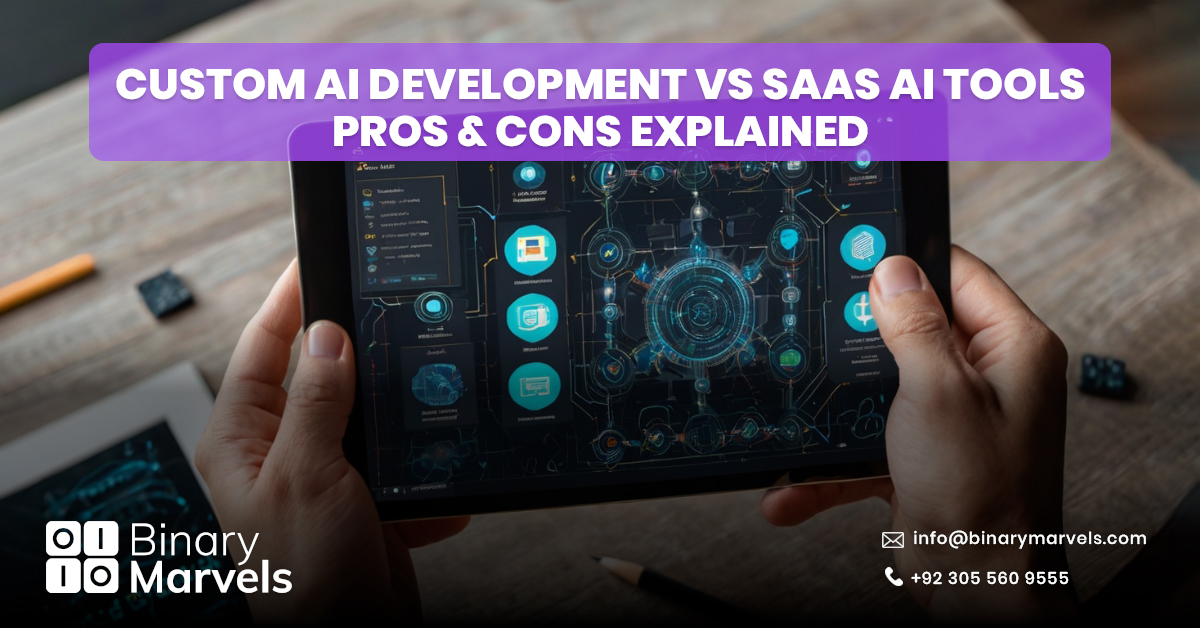
Have you ever chatted with a bot that felt almost human? That’s not magic – it’s the power of AI and NLP working together behind the scenes. As businesses and users demand faster, smarter, and more natural digital interactions, AI chatbots have stepped up to deliver. But how exactly do AI chatbots use NLP to understand what we say, respond in real time, and even recognize emotions?
In this article, we’ll explore how AI chatbots use NLP to create more human-like conversations, why it matters, and where this technology is making a real impact today. Whether you’re a developer, a business owner, or just curious about smart tech, understanding this connection can help you appreciate how far chatbots have come.
Also Read: Top 10 AI Companies in Pakistan
What Is an AI Chatbot and How Does NLP Fit In?
AI chatbots are software applications that use artificial intelligence to simulate real-time conversations with users. Unlike traditional rule-based bots that follow predefined scripts, AI chatbots can understand, learn, and respond based on the context of the conversation.
At the heart of this intelligence is Natural Language Processing (NLP). NLP is a branch of AI that helps machines understand, interpret, and respond to human language. It allows chatbots to analyze user input, detect intent, extract relevant information, and generate natural responses.
By combining AI and NLP, chatbots can go beyond basic replies and hold dynamic, human-like conversations. Whether it’s answering customer questions, helping with online shopping, or booking appointments, NLP gives chatbots the language skills they need to interact meaningfully.
How AI Chatbots Use NLP to Understand and Respond?
To make conversations feel natural, AI chatbots use NLP techniques that allow them to process and understand human language in a way that’s similar to how people do. Here’s how it works:
Intent Recognition
One of the first things an NLP-powered chatbot does is identify what the user wants. This is known as intent recognition. Whether the user is asking a question, placing an order, or making a complaint, the chatbot uses NLP to determine the purpose behind the message.
Entity Extraction
Along with understanding intent, AI chatbots also extract key details from the conversation, such as names, dates, locations, or products. This helps the bot provide relevant and personalized responses.
Sentiment Analysis
Advanced AI chatbots can detect the emotional tone behind a message using sentiment analysis. This allows them to adjust their responses based on whether the user sounds happy, frustrated, or confused.
Context Handling
Human conversations rely heavily on context. AI chatbots use NLP to remember previous messages, follow up naturally, and maintain the flow of a conversation. This makes interactions smoother and more coherent.
By combining these techniques, AI chatbots use NLP to not only understand what users are saying but also respond in ways that feel thoughtful and human.
Also Read: How AI Chatbots Improve Lead Qualification and Nurturing?
Key NLP Techniques Used in AI Chatbots
To make interactions smoother and more human-like, AI chatbots rely on several core NLP techniques. These methods help them process language, extract meaning, and respond naturally.
Natural Language Understanding (NLU)
NLU helps the chatbot understand what the user is saying. It involves breaking down a sentence to figure out the intent and extract useful information. For example, if someone types “Book me a flight to London next Monday,” NLU helps identify the action (booking), destination (London), and date (next Monday).
Named Entity Recognition (NER)
NER is used to pick out specific pieces of information from a message, such as names, dates, times, locations, and product names. This helps the chatbot tailor its response and complete tasks more accurately.
Natural Language Generation (NLG)
Once the chatbot understands the input, it needs to respond in a natural way. NLG helps generate human-like text based on the chatbot’s understanding. This makes replies feel conversational rather than robotic.
Tokenization and Lemmatization
Tokenization splits sentences into individual words or phrases, while lemmatization reduces those words to their base form. These processes help chatbots better understand and compare different variations of the same word.
By using these NLP techniques, AI chatbots can process language more effectively and create a smoother, more natural user experience.
Real-World Applications of AI Chatbots Using NLP
AI chatbots powered by NLP are being used across industries to improve customer service, automate tasks, and enhance user engagement. Here are some of the most common and impactful use cases:
Customer Support
Businesses use AI chatbots to handle common customer queries such as tracking orders, resetting passwords, or answering FAQs. NLP enables the chatbot to understand varied questions and provide quick, relevant answers without human involvement.
E-commerce Assistance
In online shopping, chatbots help users find products, recommend items based on preferences, and guide them through the checkout process. NLP allows the bot to understand product-related queries like “Show me black sneakers under $50” and respond accordingly.
Healthcare Support
Healthcare providers are using AI chatbots to answer patient questions, schedule appointments, and even perform symptom checks. NLP helps ensure the chatbot understands medical terms and responds with accurate, helpful information.
Banking and Finance
From checking account balances to helping users navigate financial services, AI chatbots in banking use NLP to offer fast and secure assistance. They can also alert users about suspicious activity or guide them through application processes.
Education and E-learning
In online learning environments, AI chatbots answer students’ questions, provide feedback, and help them find resources. NLP helps make these conversations personalized and supportive.
These real-world examples show how AI chatbots use NLP to deliver valuable, human-like assistance at scale across different sectors.
Also Read: Industries That Benefit Most from AI Chatbots in 2025
Benefits of AI Chatbots Using NLP
AI chatbots powered by NLP offer a wide range of benefits for both businesses and users. By making conversations feel more natural and responsive, they improve the overall communication experience.
Human-Like Interactions
Thanks to NLP, AI chatbots can understand language in a conversational way. This leads to smoother, more natural exchanges that feel less robotic and more engaging.
24/7 Availability
AI chatbots never need a break. They can operate around the clock, helping users at any time of day with consistent and accurate responses.
Faster Response Times
With the ability to process queries instantly, chatbots powered by NLP reduce wait times and offer immediate answers, improving user satisfaction.
Cost Efficiency
By automating routine tasks and handling high volumes of queries, AI chatbots can lower the need for large customer service teams and reduce operational costs.
Personalized Experiences
NLP allows chatbots to tailor responses based on user data, preferences, and past conversations. This helps create more relevant and personalized interactions.
Scalability
AI chatbots can manage thousands of conversations simultaneously without losing quality, making them ideal for businesses with growing customer bases.
These benefits show why more companies are turning to AI chatbots with NLP to improve their customer service and digital engagement.
Challenges in Building Human-Like AI Chatbots
While AI chatbots using NLP have come a long way, creating truly human-like conversations is still a complex task. Several challenges must be addressed to make interactions seamless and reliable.
Understanding Ambiguous Language
Human language is often unclear or has multiple meanings. Chatbots can struggle with slang, sarcasm, regional phrases, or vague requests, which can lead to incorrect responses.
Maintaining Context Over Long Conversations
Keeping track of context across multiple turns in a conversation is difficult. Without proper context management, chatbots may give answers that feel disconnected or repetitive.
Handling Complex Queries
When users ask multi-part or highly technical questions, AI chatbots may not always interpret them accurately. This can require handoffs to human agents, especially in sensitive situations.
Language and Cultural Differences
Building multilingual support and adapting to different cultural tones or expressions is challenging. NLP models must be trained with diverse data to handle global user bases effectively.
Data Privacy and Security
Since chatbots often handle personal or sensitive information, protecting user data is critical. Developers must ensure compliance with privacy regulations and implement secure data handling practices.
These challenges highlight the need for continuous improvement, testing, and ethical design when developing AI chatbots that rely on NLP.
Also Read: How AI Chatbots Reduce Support Costs and Improve Response Times?
Best Practices for Designing AI Chatbots with NLP
Creating an effective AI chatbot that feels natural and human-like requires more than just advanced technology. Following certain best practices ensures the chatbot delivers accurate, friendly, and helpful interactions.
Use Clear and Simple Language
Train your chatbot to understand and respond in a way that’s easy for users to follow. Avoid overly technical terms unless necessary, and keep the tone conversational.
Train on Diverse and Real Data
The quality of your chatbot’s responses depends on the data it learns from. Use real conversations, FAQs, and user queries to train NLP models so they can handle different communication styles and topics.
Include Fallback Responses
No chatbot is perfect. When it doesn’t understand a question, it should respond politely and offer alternative options, such as rephrasing the question or connecting to a human agent.
Personalize the Conversation
Use available user data to make the interaction more relevant. Simple touches like using the user’s name or remembering past interactions can significantly improve the experience.
Keep Improving with Feedback
Collect data from actual conversations and continuously update the chatbot’s NLP model. User feedback and error analysis help identify gaps and improve accuracy over time.
Align the Bot’s Tone with Your Brand
Whether your brand is formal, friendly, or playful, the chatbot’s language should match. Consistent tone builds trust and makes the conversation feel more authentic.
By applying these best practices, developers and businesses can build AI chatbots that truly leverage NLP to create valuable, human-like digital interactions.
Future Trends in AI Chatbots and NLP
As technology evolves, AI chatbots powered by NLP are becoming smarter, more intuitive, and more human-like. Here are some key trends shaping the future of this space.
Integration with Generative AI
The rise of large language models like GPT has taken chatbot capabilities to the next level. These models can generate responses that are not only accurate but also contextually rich and conversational, making interactions feel more natural.
Voice-Enabled Conversations
Text-based chat is just the beginning. Voice-enabled AI chatbots are growing in popularity, allowing users to speak naturally and receive spoken responses. This adds convenience and accessibility to digital interactions.
Emotionally Intelligent Chatbots
Future chatbots will be better at recognizing and responding to human emotions. With improved sentiment analysis, they’ll adapt tone, language, and response style to match the user’s mood and needs.
Multilingual and Cross-Cultural Support
AI chatbots are becoming more adept at handling multiple languages and regional variations. This makes them more useful for global audiences and ensures a smoother experience for non-native speakers.
Smarter Context Handling
Advancements in memory and context awareness will help chatbots remember user preferences, past conversations, and more complex interactions, making every exchange feel more personal and meaningful.
These trends show that AI chatbots using NLP are not just improving—they’re evolving into digital assistants that can genuinely understand and assist people across various platforms and industries.
Supercharge Your Business with AI Today!
As a trusted AI Development Company in Pakistan, we deliver cutting-edge AI Development Services designed to streamline your operations and enhance customer engagement.
Don’t wait—connect with us now and take your business to the next level!
Conclusion
AI chatbots using NLP are transforming how businesses and users communicate. By understanding language, emotions, and context, these chatbots go beyond simple responses and create conversations that feel natural and engaging.
From customer support and e-commerce to healthcare and education, NLP-powered chatbots are being used to solve real problems and improve user experience. While challenges like ambiguity and context management still exist, continuous advancements in AI and language models are quickly closing the gap between human and machine interaction.
As this technology continues to evolve, AI chatbots will become even more intelligent, personalized, and emotionally aware, making them a valuable asset for any digital-first strategy.
FAQs
What is the role of NLP in AI chatbots?
NLP allows AI chatbots to understand, interpret, and respond to human language in a way that feels natural. It helps detect intent, extract key information, and generate relevant replies.
Can AI chatbots really understand emotions?
Yes, with sentiment analysis, many AI chatbots can recognize basic emotions like happiness, frustration, or confusion and adjust their responses accordingly.
What makes AI chatbots better than rule-based bots?
AI chatbots can learn from data, understand context, and handle a wider range of queries. Rule-based bots follow fixed scripts and struggle with unpredictable input.
Are NLP-based chatbots only for large businesses?
No, businesses of all sizes can use AI chatbots. Many platforms offer scalable solutions that fit small businesses, startups, and enterprises alike.
How do AI chatbots keep conversations human-like?
By using NLP techniques like intent recognition, sentiment analysis, and contextual memory, AI chatbots can hold more natural and engaging conversations over time.









